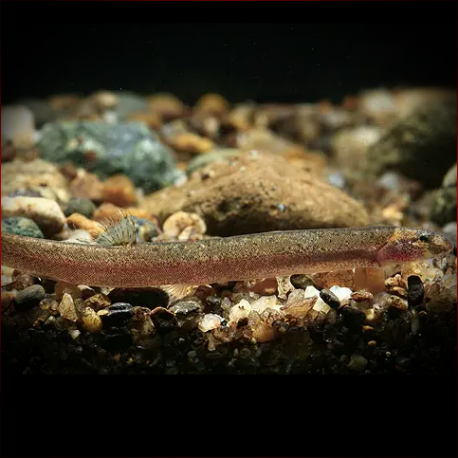More info
Datasheet
| Minimum Tank Size | 40 litres / 10.57 US gallons |
| Maximum Size | 6.0cm / 2.36inches |
| Temperature | 21°C / 69.80°F - 26°C / 78.80°F |
| Hardness | 0.00dgH / 0ppm - 8.01dgH / 143ppm |
| pH | 4.0-7.5 |
General Description
Pangio Piperata, a member of the Cobitidae family within the Cypriniformes order, is a small species with a maximum size of around 6.0cm. It is chiefly a micropredator, sifting through substrate for insect larvae and small crustaceans while also consuming organic detritus and plant material.
Aquarium Setup
For an optimal aquarium setup for Pangio Piperata, a soft, sandy substrate is recommended to accommodate their digging behavior. Providing driftwood roots and branches to create shaded areas, along with dried leaf litter for cover, can mimic their natural habitat. Adding aquatic plants such as Microsorum, Taxiphyllum, and Cryptocoryne spp. is beneficial. Gentle filtration with minimal surface agitation is advised, and precautions should be taken to prevent small specimens from entering filter intakes.
Behaviour
Pangio Piperata are peaceful towards both their species and other tankmates. They are known to aggregate closely in nature and will often group together in captivity. Therefore, it is suggested to keep a minimum of 5-6 specimens together. Compatible tankmates include small, peaceful species from similar environments.
Feeding and Diet
In their natural habitat, Pangio Piperata feed on insect larvae, small crustaceans, and plant material found in the substrate. In an aquarium setting, they will accept sinking dried foods but should also be offered live and frozen options like Daphnia, Artemia, and bloodworms to ensure a well-rounded diet.
Reproduction & Dimorphism
Information about the reproduction of Pangio Piperata is unrecorded. Adult females typically have a heavier body and are slightly larger than males. Mature males can be distinguished by the presence of a branched and thickened first pectoral-fin ray.
Habitat and Distribution
Pangio Piperata is primarily found in shallow, slow-moving sections of forest streams, swamps, and backwaters in regions such as Peninsular Malaysia, Thailand, and parts of Borneo. They thrive in habitats with soft, shaded waters containing minimal dissolved minerals and a pH that can be as low as 3.0 or 4.0. The species is believed to have populations in different regions, potentially indicating more than one species despite lacking distinct morphological variations.

